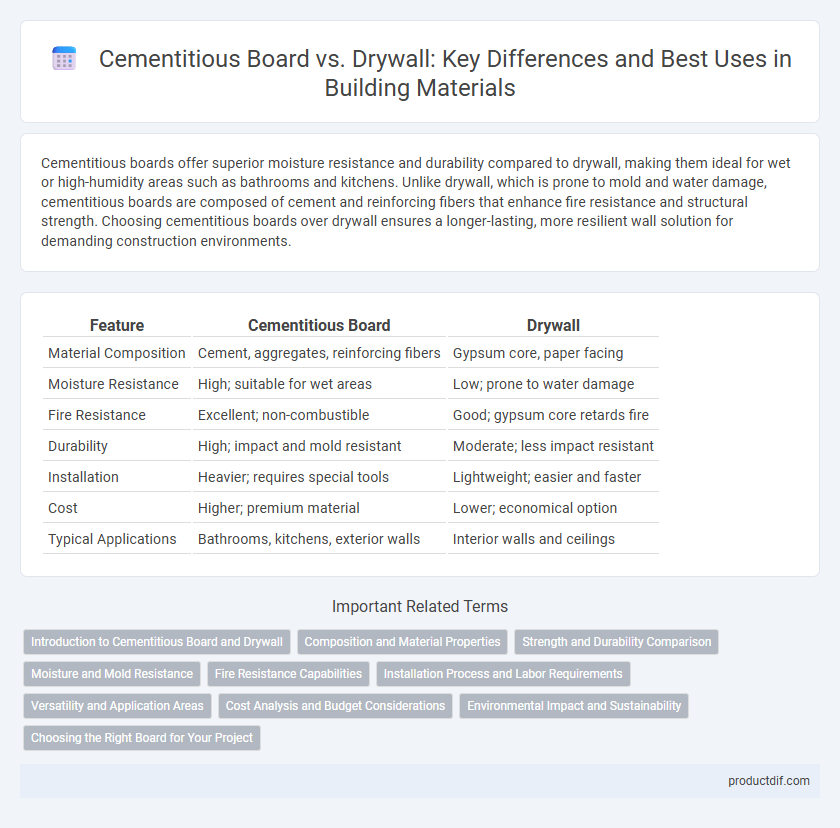Cementitious boards offer superior moisture resistance and durability compared to drywall, making them ideal for wet or high-humidity areas such as bathrooms and kitchens. Unlike drywall, which is prone to mold and water damage, cementitious boards are composed of cement and reinforcing fibers that enhance fire resistance and structural strength. Choosing cementitious boards over drywall ensures a longer-lasting, more resilient wall solution for demanding construction environments.
Table of Comparison
| Feature | Cementitious Board | Drywall |
|---|---|---|
| Material Composition | Cement, aggregates, reinforcing fibers | Gypsum core, paper facing |
| Moisture Resistance | High; suitable for wet areas | Low; prone to water damage |
| Fire Resistance | Excellent; non-combustible | Good; gypsum core retards fire |
| Durability | High; impact and mold resistant | Moderate; less impact resistant |
| Installation | Heavier; requires special tools | Lightweight; easier and faster |
| Cost | Higher; premium material | Lower; economical option |
| Typical Applications | Bathrooms, kitchens, exterior walls | Interior walls and ceilings |
Introduction to Cementitious Board and Drywall
Cementitious board is a durable building material composed of cement and reinforcing fibers, engineered for moisture resistance and fire protection in construction applications. Drywall, also known as gypsum board, consists primarily of a gypsum core sandwiched between paper layers, widely used for interior wall and ceiling partitions due to its ease of installation and cost-effectiveness. Both materials serve distinct purposes, with cementitious boards excelling in high-moisture or fire-prone environments, while drywall remains a standard choice for general interior spaces.
Composition and Material Properties
Cementitious boards consist of cement, reinforcing fibers, and additives that provide high moisture resistance and durability, making them suitable for exterior and wet environments. Drywall, primarily composed of gypsum plaster sandwiched between paper layers, offers ease of installation and cost-effectiveness but lacks significant moisture and impact resistance. The denser composition of cementitious boards results in superior fire resistance and structural strength compared to the lighter, more fragile drywall panels used in interior construction.
Strength and Durability Comparison
Cementitious board offers superior strength and durability compared to drywall due to its composition of cement and reinforcing fibers, which provide enhanced resistance to impact, moisture, and fire. Unlike drywall, cementitious board does not easily sag or deteriorate when exposed to water, making it ideal for high-moisture environments such as bathrooms and kitchens. Its robustness extends the lifespan of walls and reduces maintenance needs, positioning it as a more resilient building material for both commercial and residential construction.
Moisture and Mold Resistance
Cementitious boards offer superior moisture and mold resistance compared to drywall, making them ideal for high-humidity environments like bathrooms and basements. Unlike drywall, which can absorb water and promote mold growth, cementitious boards are composed of cement and reinforcing fibers, providing enhanced durability and preventing mold development. This resistance significantly extends the lifespan of wall assemblies in moisture-prone areas, reducing maintenance and replacement costs.
Fire Resistance Capabilities
Cementitious boards exhibit superior fire resistance compared to drywall due to their non-combustible composition, often meeting or exceeding ASTM E119 fire ratings. Unlike drywall, which can degrade under prolonged exposure to high temperatures, cementitious boards maintain structural integrity, making them ideal for fire-rated assemblies in commercial and residential buildings. Their enhanced fire resistance capabilities contribute to improved safety and compliance with stringent building codes.
Installation Process and Labor Requirements
Cementitious boards require specialized cutting tools and waterproof adhesives for installation, making the process more labor-intensive than drywall. Drywall installation utilizes standard drywall screws and joint compound, allowing quicker assembly with less specialized skill. The drying and curing times for cementitious boards extend project timelines compared to the rapid finishing capabilities of drywall systems.
Versatility and Application Areas
Cementitious boards offer superior moisture and fire resistance, making them ideal for wet areas like bathrooms, kitchens, and exterior walls compared to traditional drywall. Their durability and strength allow for use in high-impact zones and as a base for tile installations, which drywall cannot reliably support. Drywall remains a cost-effective and easy-to-install option for standard interior walls and ceilings, but lacks the versatility of cementitious boards in demanding environments.
Cost Analysis and Budget Considerations
Cementitious boards generally have a higher upfront cost than drywall but offer superior durability and moisture resistance, which can reduce long-term maintenance expenses. Drywall remains a more budget-friendly option for large-scale projects due to lower material and installation costs. When comparing both, it is crucial to consider lifecycle costs, including installation labor, repair frequency, and the specific environmental conditions of the building site.
Environmental Impact and Sustainability
Cementitious boards offer superior durability and moisture resistance compared to drywall, resulting in a longer lifespan and reduced waste generation in construction projects. Unlike gypsum-based drywall, cementitious boards often incorporate recycled industrial by-products like fly ash, enhancing their environmental sustainability by reducing raw material extraction. Disposal of cementitious boards has a lower environmental footprint as they resist mold and deterioration, minimizing the need for replacement and contributing to sustainable building practices.
Choosing the Right Board for Your Project
Cementitious boards offer superior moisture resistance and durability, making them ideal for high-humidity areas like bathrooms and kitchens, whereas drywall is more cost-effective and easier to install in standard interior walls. Consider project requirements such as exposure to water, fire resistance, and desired lifespan when selecting between cementitious board and drywall. Optimal performance relies on choosing a board that balances budget constraints with environmental factors and structural demands.
Cementitious Board vs Drywall Infographic

 productdif.com
productdif.com